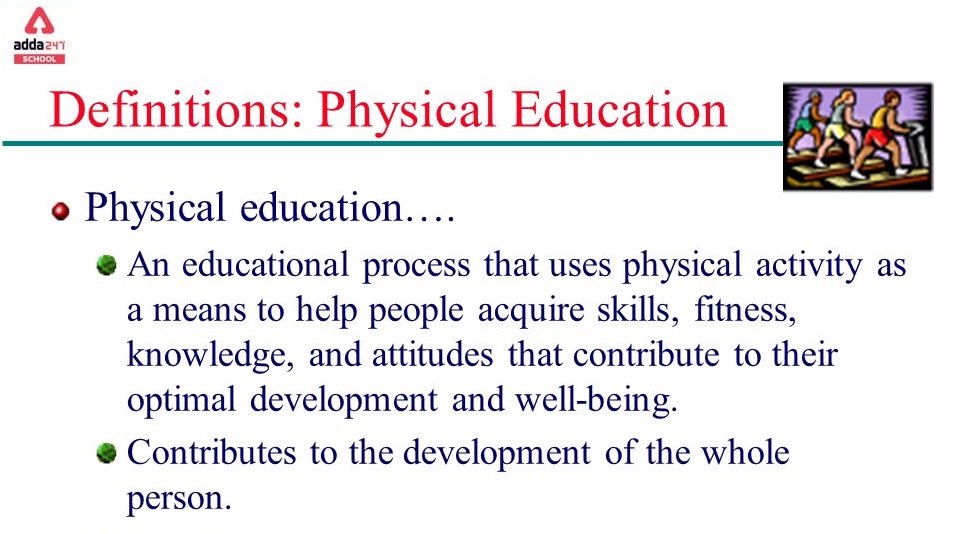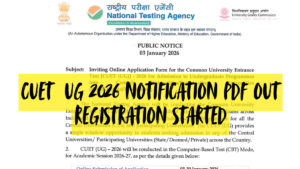What is Physical Education Meaning
Physical education (Phys Ed. or P.E.) is a subject that is taught in schools all around the world. It is commonly taught in primary and secondary schools, and it promotes health and physical fitness by encouraging psychomotor learning through play and movement exploration. Football, netball, hockey, rounders, cricket, four square, racing, and a variety of other children’s games are among the activities offered in P.E. Nutrition, healthy behaviours, and individuality of needs are also taught in physical education.
What is Physical Education Definition?
Physical education programs differ from country to country. P.E. class, when taught properly, can have a good impact on students’ health, behavior, and academic performance. The main goals of modern physical education are to provide active role models, individualise duration, intensity, and type of activity, encourage self-reporting and monitoring of exercise, teach skills to maintain a lifetime of fitness and health, and expose children and teens to a wide variety of exercise and healthy activities. P.E. is one of the few options for children to engage in good and healthful activities because it is available to nearly all of them. Aerobic, muscle-strengthening, bone-strengthening, and stretching are the four main types of physical activity. Each one works in a distinct way to maintain your body trim and healthy. Stretching targets joints and promotes flexibility, while aerobic benefits your heart and lungs the most.
Define Physical Education Benefits
Children and teenagers can reap a slew of health benefits if they are educated correctly and in a good manner. Reduced metabolic disease risk, improved cardiological fitness, and improved mental health are just a few of the benefits. There is also a link between brain growth and physical activity, according to research. Physical education can also help students achieve academic success. In 2007, researchers discovered a significant increase in English Arts standardised exam results among kids who had 56 hours of physical education in a year compared to those who had 28 hours.
The Use of Technology in Physical Education
Many physical education classrooms use technology to help their students exercise effectively. A simple video recorder is one of the most affordable and often used equipment. Students can use this to record themselves and then review the recordings to see what faults they are doing in activities like throwing or swinging. Students find this more helpful than having someone try to explain what they’re doing wrong and then try to remedy it, according to studies. Educators can also employ technology like pedometers and heart rate monitors to help kids set step and heart rate objectives. Video projectors and GPS systems are two other technologies that can be employed in a physical education context.
Physical Education: Syllabus
Physical education is a school-based subject that emphasises the development of physical fitness and the capacity to perform and enjoy everyday physical activities. Kids get the skills they need to engage in a variety of sports, including soccer, basketball, and swimming. Physical educators must promote and strengthen growing motor skills, as well as equip children and teenagers with a fundamental skill set that expands their movement repertory, allowing them to participate in a variety of games, sports, and other physical activities throughout their lives. These objectives can be met in a variety of ways. National, state, and municipal criteria often specify which physical education standards must be taught. The subject presented, the credentials required of instructors, and the textbooks and materials that must be utilised are all determined by these criteria.
These methods and curricula are based on pioneers in physical education, such as Francois Delsarte, Liselott Diem, and Rudolf von Laban, who emphasised on a child’s ability to utilise their body for self-expression in the 1800s. This, together with 1960s techniques (which included the use of the body, spatial awareness, effort, and relationships), gave birth to modern physical education teaching.
What is Physical Education in Hindi?
शारीरिक शिक्षा क्या है? – परिभाषा
शारीरिक शिक्षा (फिजिक्स एड या पीई) एक ऐसा विषय है जो दुनिया भर के स्कूलों में पढ़ाया जाता है। यह आमतौर पर प्राथमिक और माध्यमिक विद्यालयों में पढ़ाया जाता है, और यह खेल और आंदोलन की खोज के माध्यम से साइकोमोटर सीखने को प्रोत्साहित करके स्वास्थ्य और शारीरिक फिटनेस को बढ़ावा देता है। फुटबॉल, नेटबॉल, हॉकी, राउंडर, क्रिकेट, चार वर्ग, रेसिंग, और कई अन्य बच्चों के खेल पीई में दी जाने वाली गतिविधियों में से हैं। शारीरिक शिक्षा में पोषण, स्वस्थ व्यवहार और आवश्यकताओं की वैयक्तिकता भी सिखाई जाती है।
What is Physical Education Essay in Hindi?
शारीरिक शिक्षा कार्यक्रम हर देश में अलग-अलग होते हैं। पी.ई. कक्षा, जब ठीक से पढ़ाया जाता है, छात्रों के स्वास्थ्य, व्यवहार और शैक्षणिक प्रदर्शन पर अच्छा प्रभाव डाल सकता है। आधुनिक शारीरिक शिक्षा के मुख्य लक्ष्य सक्रिय रोल मॉडल प्रदान करना, अवधि, तीव्रता और गतिविधि के प्रकार को अलग करना, व्यायाम की आत्म-रिपोर्टिंग और निगरानी को प्रोत्साहित करना, जीवन भर फिटनेस और स्वास्थ्य बनाए रखने के लिए कौशल सिखाना और बच्चों और किशोरों को उजागर करना है। व्यायाम और स्वस्थ गतिविधियों की एक विस्तृत विविधता। पी.ई. बच्चों के लिए अच्छी और स्वस्थ गतिविधियों में संलग्न होने के कुछ विकल्पों में से एक है क्योंकि यह लगभग सभी के लिए उपलब्ध है। एरोबिक, मांसपेशियों को मजबूत करना, हड्डियों को मजबूत करना और खींचना चार मुख्य प्रकार की शारीरिक गतिविधि हैं। आपके शरीर को सुडौल और स्वस्थ बनाए रखने के लिए हर एक अलग तरीके से काम करता है। स्ट्रेचिंग जोड़ों को लक्षित करता है और लचीलेपन को बढ़ावा देता है, जबकि एरोबिक आपके दिल और फेफड़ों को सबसे ज्यादा फायदा पहुंचाता है।
शारीरिक शिक्षा के लाभ
यदि बच्चों और किशोरों को सही तरीके से और अच्छी तरह से शिक्षित किया जाए तो वे कई स्वास्थ्य लाभ प्राप्त कर सकते हैं। चयापचय रोग के जोखिम में कमी, कार्डियोलॉजिकल फिटनेस में सुधार और मानसिक स्वास्थ्य में सुधार कुछ ही लाभ हैं। शोध के अनुसार, मस्तिष्क के विकास और शारीरिक गतिविधि के बीच एक कड़ी भी है। शारीरिक शिक्षा भी छात्रों को अकादमिक सफलता प्राप्त करने में मदद कर सकती है। 2007 में, शोधकर्ताओं ने उन बच्चों के बीच अंग्रेजी कला मानकीकृत परीक्षा परिणामों में उल्लेखनीय वृद्धि की खोज की, जिनके पास 28 घंटे की तुलना में एक वर्ष में 56 घंटे की शारीरिक शिक्षा थी।
शारीरिक शिक्षा में प्रौद्योगिकी का उपयोग
कई शारीरिक शिक्षा कक्षाएं अपने छात्रों को प्रभावी ढंग से व्यायाम करने में मदद करने के लिए प्रौद्योगिकी का उपयोग करती हैं। एक साधारण वीडियो रिकॉर्डर सबसे किफायती और अक्सर उपयोग किए जाने वाले उपकरणों में से एक है। छात्र इसका उपयोग खुद को रिकॉर्ड करने के लिए कर सकते हैं और फिर रिकॉर्डिंग की समीक्षा करके देख सकते हैं कि वे फेंकने या झूलने जैसी गतिविधियों में क्या दोष कर रहे हैं। अध्ययन के अनुसार, छात्रों को यह समझाने की कोशिश करने से ज्यादा मददगार लगता है कि वे क्या गलत कर रहे हैं और फिर इसे ठीक करने का प्रयास करें। बच्चों को कदम और हृदय गति के उद्देश्यों को निर्धारित करने में मदद करने के लिए शिक्षक पेडोमीटर और हृदय गति मॉनिटर जैसी तकनीक का भी उपयोग कर सकते हैं। वीडियो प्रोजेक्टर और जीपीएस सिस्टम दो अन्य प्रौद्योगिकियां हैं जिन्हें शारीरिक शिक्षा के संदर्भ में नियोजित किया जा सकता है।
शारीरिक शिक्षा: पाठ्यक्रम
शारीरिक शिक्षा एक स्कूल-आधारित विषय है जो शारीरिक फिटनेस के विकास और रोजमर्रा की शारीरिक गतिविधियों को करने और आनंद लेने की क्षमता पर जोर देता है। बच्चों को फ़ुटबॉल, बास्केटबॉल और तैराकी सहित विभिन्न प्रकार के खेलों में शामिल होने के लिए आवश्यक कौशल प्राप्त होते हैं। शारीरिक शिक्षकों को बढ़ते मोटर कौशल को बढ़ावा देना और मजबूत करना चाहिए, साथ ही बच्चों और किशोरों को एक मौलिक कौशल सेट से लैस करना चाहिए जो उनके आंदोलन प्रदर्शनों का विस्तार करता है, जिससे उन्हें अपने पूरे जीवन में विभिन्न प्रकार के खेल, खेल और अन्य शारीरिक गतिविधियों में भाग लेने की अनुमति मिलती है। इन उद्देश्यों को विभिन्न तरीकों से पूरा किया जा सकता है। राष्ट्रीय, राज्य और नगरपालिका मानदंड अक्सर निर्दिष्ट करते हैं कि कौन से शारीरिक शिक्षा मानकों को पढ़ाया जाना चाहिए। प्रस्तुत विषय, प्रशिक्षकों के लिए आवश्यक साख, और पाठ्यपुस्तकों और सामग्रियों का उपयोग किया जाना चाहिए जो सभी इन मानदंडों द्वारा निर्धारित किए जाते हैं।
ये तरीके और पाठ्यक्रम शारीरिक शिक्षा में अग्रदूतों पर आधारित हैं, जैसे कि फ्रेंकोइस डेल्सर्ट, लिसेलॉट डायम और रुडोल्फ वॉन लाबान, जिन्होंने 1800 के दशक में आत्म-अभिव्यक्ति के लिए अपने शरीर का उपयोग करने की एक बच्चे की क्षमता पर जोर दिया था। इसने 1960 के दशक की तकनीकों (जिसमें शरीर का उपयोग, स्थानिक जागरूकता, प्रयास और संबंध शामिल थे) के साथ मिलकर आधुनिक शारीरिक शिक्षा शिक्षण को जन्म दिया।
What is Physical Education PDF?
Download Now: What is Physical Education PDF
Read More Essay:
Independence Day Speech In English
Hindi For KidsHealth Is Wealth Essay/Speech
Water Conservation- Save Water Save Life Essay









 NEET UG 2026 Registration: NTA releases ...
NEET UG 2026 Registration: NTA releases ...
 CUET UG 2026 Online Registration Started...
CUET UG 2026 Online Registration Started...
 CUET 2026 Free Batches Launched by CUET ...
CUET 2026 Free Batches Launched by CUET ...














